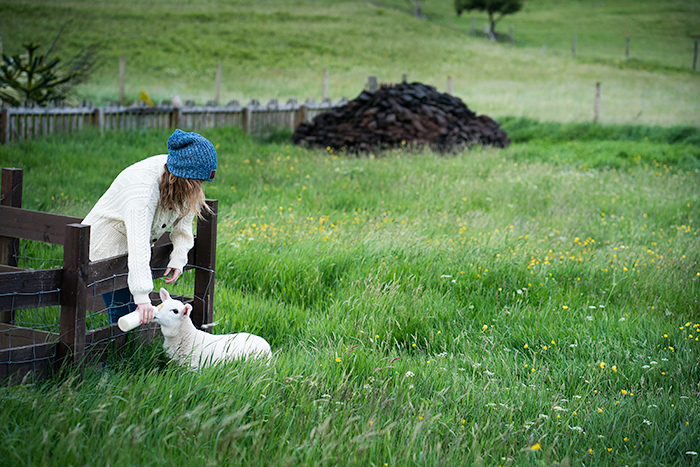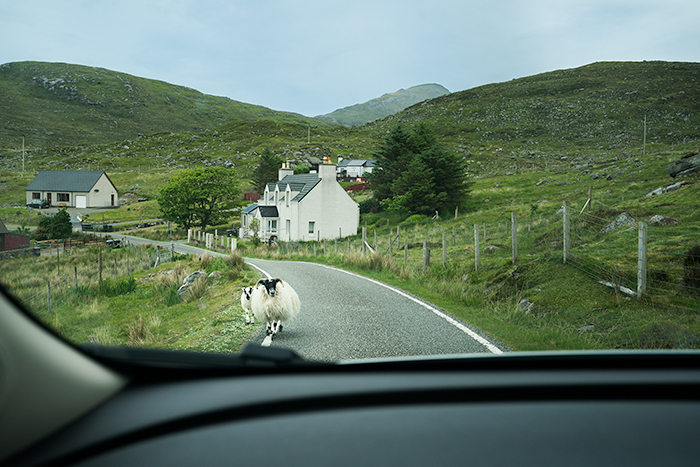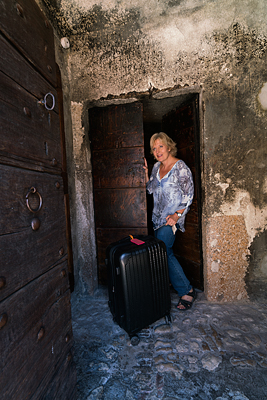
 Animal lovers unite. Who doesn’t love Scotland’s hairy coos & cute ewes?
Animal lovers unite. Who doesn’t love Scotland’s hairy coos & cute ewes?


These animals are iconic sights in the rural rolling landscapes of Scotland. Chances are high that you’ll spot them on any road trip venturing away from city lights into the countryside. But you can up your chances significantly if you know where to look!
Rounding a curve on the Isle of Lewis …Well, hellooo there!


Random Facts about SHEEP (or ewes):
There are almost 7 million sheep in Scotland — more than people!
Where can you find them? The greatest concentration of sheep can be seen in the south, the Highlands, and the islands. More specifically in the Borders (south of Edinburgh) & Dumfries and Galloway (Lowlands in the southwest), although we really didn’t see many here during our road trip except in the distance while driving through rolling hills that had no place to pull over. We had better luck seeing more sheep, and having opportunities to get close to them in the islands of Skye and Lewis & Harris in the Outer Hebrides.
Types:
Black-faced sheep with white fleece is the most common, as they are the hardiest breed to withstand strong winds and uneven terrain on the outer islands. Their fine to coarse wool is used for weaving Harris tweed and making carpets or Italian mattresses.
Cheviot sheep are cream colored, found mainly in the southern part of the country.
Seasonal schedule:
Lambing begins in late spring, and these cute little ewes spend summers running through grasses and grazing on hilly pastures.

 June is when shepherds mark their sheep with colored spots.
June is when shepherds mark their sheep with colored spots.

 July begins the shearing season. In September, selected lambs go to other grazing fields to fatten up, and in October rams and older sheep go to market. Rams mate the end of November.
July begins the shearing season. In September, selected lambs go to other grazing fields to fatten up, and in October rams and older sheep go to market. Rams mate the end of November.
Highland Clearances
During a controversial time in Scottish history, from 1750 to 1860 to be exact, the ruling class valued sheep more than people. Entire communities were forced from their homes in the western islands & Highlands to make way for more sheep and large scale pastoral sheep farms. Displaced tenants were expected to eke out a living in the kelp or fishing industry on the islands as their newly appointed crofting communities were moved to rocky lands unsuitable for farming. Famine, resentment, and dwindling income (due to the dying kelp trade) caused many families to emigrate from their home country to America or Canada. Some went voluntarily, but others like the entire population of 3,000 tenants on Barra island were tricked onto a ship heading to Canada under the orders of Colonel John Gordon Cluny in 1851. (The Jaws of Sheep: The 1851 Hebridean Clearances of Gordon of Cluny, published by Harvard University, details the Clearances on the Outer Hebrides.)
Today farmers raise small flocks of sheep and cattle on their crofting properties. There is a strong sense of community here on the islands, such as Lewis, where locals know their neighbors even if it’s driving distance away. (Unlike the States — where let’s be real, most of us have no clue who lives next door!)
ISLE of LEWIS & HARRIS
On this 40-mile island, you will still see a lot of sheep. Chances are if you rent a farmhouse like we did during our visit, that the owner will either have sheep or know a neighbor who does. And if you express interest perhaps you too can arrange a visit with a sheep farmer.


This farmer whistles a series of distinctive commands to his Border Collies to round up the sheep.


Once the sheep are successfully herded into the corner, the sheep dog carefully watches them, ready to pounce into action should the sheep decide to stray… The Border Collies are alert and dedicated workers. This one could hardly contain his excitement to sit still and would creep a little closer when no one was watching. Was kinda comical.


Sheep roam in common grazing grounds, so you might even see one admiring the beach like this one at Reef Beach in Valtos (near Uig beach).


The sheep farmer knew another a farmer down the road that was bottle feeding little lambs…so off we went!


My daughter was a natural feeding the lamb. And when she picked it up, the little lamb hugged her affectionately. Not just once, but three times. Adorable.


ISLE of SKYE
Then we traveled back toward the mainland, to another island, Skye, by ferry. We drove from Uig port across the mountain road to the tiny crofting community of Digg, north of Staffin in Trotternish Peninsula, and rented one of twin cottages on a working croft where the farmers lived in a home across the pasture closer to the sea.
They happened to have a little runt that they were raising as a pet that had to be bottle fed twice a day. Seeing my daughter’s enthusiasm talking to the little lamb, the owners asked if she would like to feed it. And of course you know that answer! 😉


There were several sheep farms in this area. One day the neighbor next door was training his Border Collies to follow whistle commands. Another morning we walked along the road from our cottage to collect eggs from a freestanding kiosk and and passed this croft. I didn’t realize how skittish sheep are. When they heard a strange noise they zipped into formation, creating a single line to cross the little footbridge over a creek. (I didn’t have my camera that morning, but took this later, hoping for a repeat performance that I could catch on video.)

 Behind the farmhouse is Quairang Mountain, which we hiked one afternoon. And what do you suppose we saw on the trail? Yep.
Behind the farmhouse is Quairang Mountain, which we hiked one afternoon. And what do you suppose we saw on the trail? Yep.


So that pretty much covers our experiences with sheep which was more plentiful than cows. As you can see, the sheep viewing is rather random. But you can definitely up your chances by visiting the islands or renting cottages or farmhouses on crofts!
Lodging options for chance encounters with Scotland’s hairy coos & cute ewes:
Curious where we stayed? Both HIGHLY recommended for their hospitality, location, accommodations and affordability:
Isle of Lewis – Taigh Granaidh Granny’s Home is a bright, spacious farmhouse with 3 bedrooms, 2 full baths, a contemporary kitchen and comfy sitting room with books, music and games that you spread out comfortably and have all to yourself. Located near the famous Callanish Standing Stones too. Hosts are extremely friendly and helpful! I really can’t imagine a better place to stay on the island. We all loved our 4 nights here, and it was one of our top stays in Scotland.
Isle of Skye – Kenmore Cottage was smaller, with tighter bedrooms and kitchen, but adequate and comfortable furnishings (even a washer/dryer). Mairi is a lovely host. Located near Quairang Mountain in the northern region of Skye–don’t miss this fantastic hike!
Romesdal Croft is a small farm that raises Highland Cattle on the Isle of Skye. They have B&B services for 1-2 guests. Has a double bed with private bathroom in one room and a separate sitting room overlooking the farm upstairs. No pets allowed since they also have a small flock of Cheviot sheep, plus 3 border collie sheepdogs. Located in Trotternish Peninsula on Isle of Skye (south of ferry port to catch ride to Lewis Island). Check out their page to inquire about a stay: RomesdalHighlanders.
Farm Stays: Experience life on a farm, get close to animals or help out with the chores. Each stay is different. Farms are scattered around the country. Find your perfect fit by reading through the 147 lodging options described on this site: VisitScotland Farm Holidays.
Long-horned Highland Cattle
The same farmer we visited on the Isle of Lewis raised long-horned cattle, or hairy coos. This is the only time we were close enough to photograph them in Scotland.


Well, except for finding them on the edge of a curvy road while driving on Lewis!


Random facts about HIGHLAND CATTLE:
Highland cattle, or hairy coos, is a Scottish breed that dates back to the 6th century. They were a sign of wealth among the clans. Feuds often ensued just to raid their cattle.
Long horns and long-fringed wavy shaggy hair ranges in color from reddish-brown ginger to black. This hardy breed has a double coat of hair that insulates and protects them from frequent rains and gale force winds in the hilly highlands and windswept islands in the cold climes of northern Scotland. Perfectly acclimated, they don’t need barns, but do congregate in open stone shelters (folds) at night. They graze on peaty acidic soil — handy for farmers as the soil is not appropriate for growing many crops. In winter, cows use horns for digging in snow to find roots to eat and other sparse vegetation. Raised for its high quality beef, the meat is tender, lean with 40% less fat and cholesterol than other types of beef. Their milk contains a very high butterfat content.


Where? Find them in fields all over Scotland on farms not far from large cities to remote islands. Best chance is to head to the Highlands, Isle of Skye or Isle of Lewis & Harris in the Outer Hebrides. Random finds, as they’re often moved to different grazing ground. But some farms offer “safaris” or lodging where you can get up and personal. But not too personal–cows weigh up to 1,100 pounds and bulls up to 1,800 lbs– and those horns are pretty sharp! But in the company of their farmer guests can get close enough to touch them as they are fairly docile.


This breed originated in the Highlands and Outer Hebrides. But you may see them elsewhere as Scottish hairy coos have been exported to Canada, Scandinavia, USA and Australia.
Do you have a favorite place to see Scotland’s hairy coos & cute ewes? Please mention it below for all of us who want to be in the know.


.jpg)
